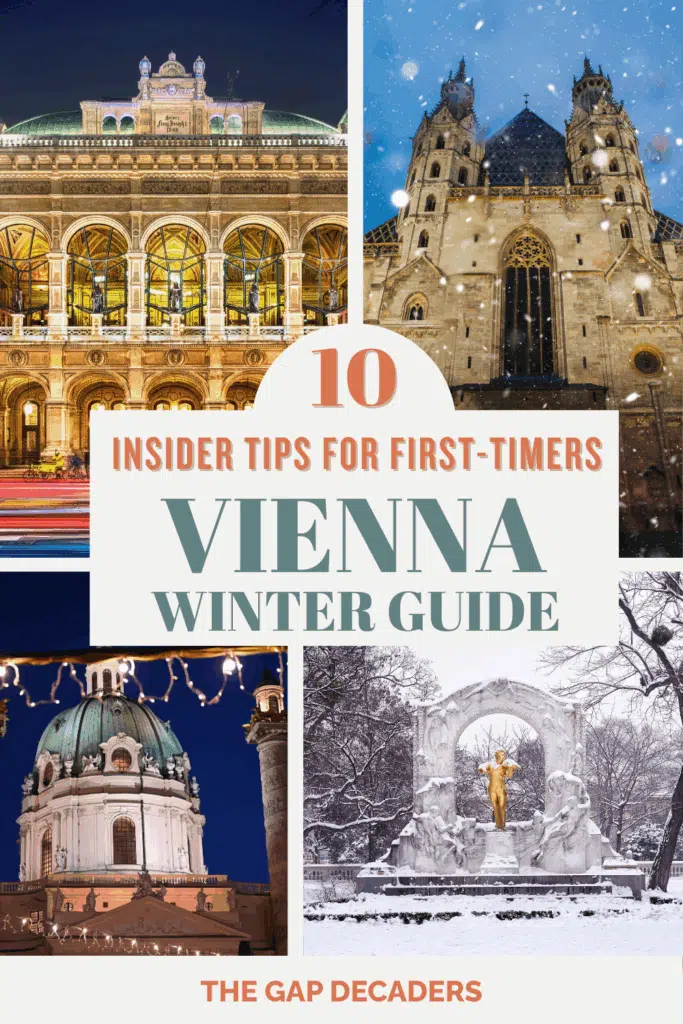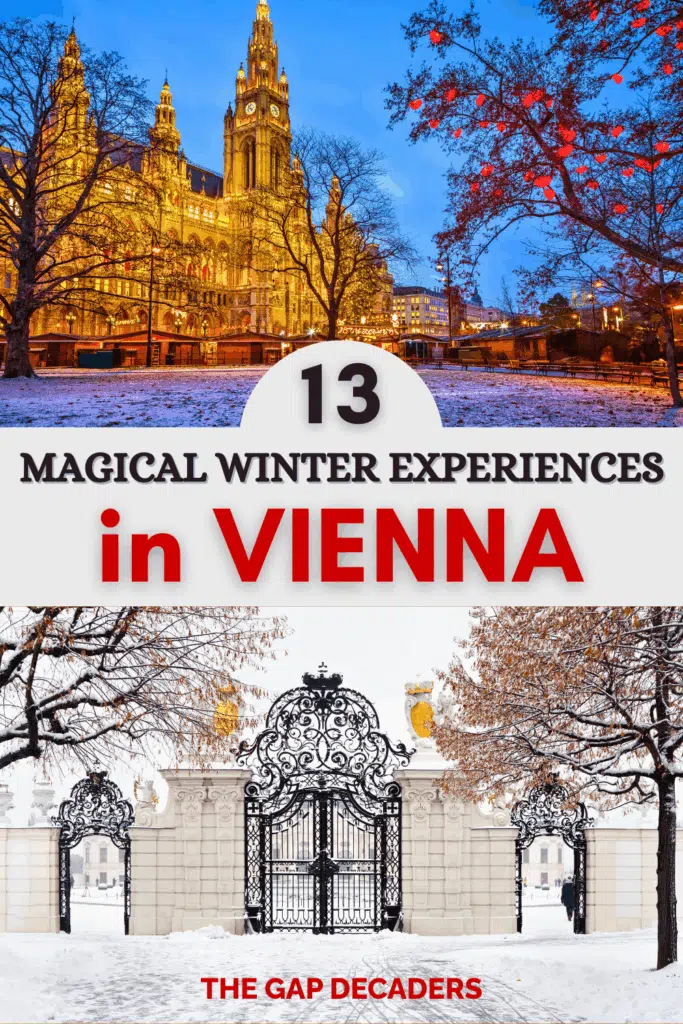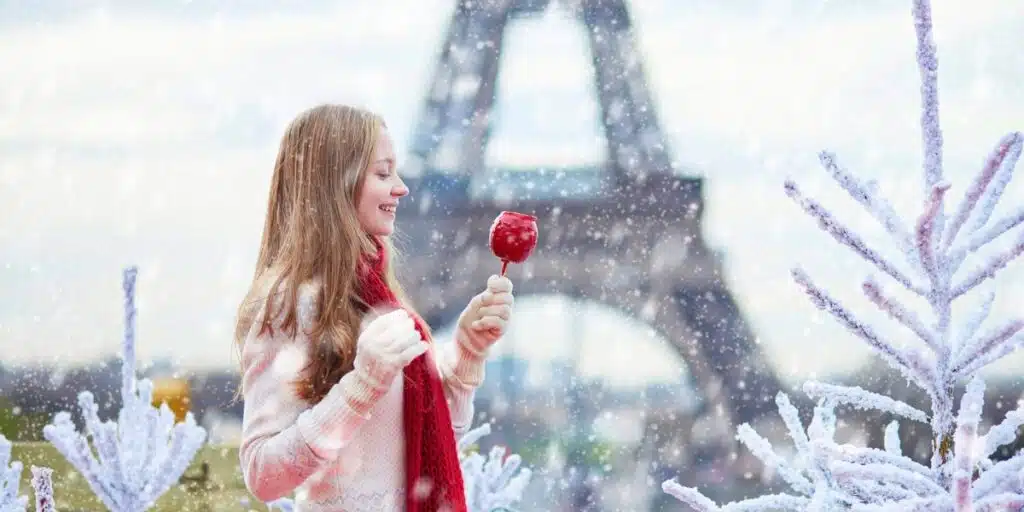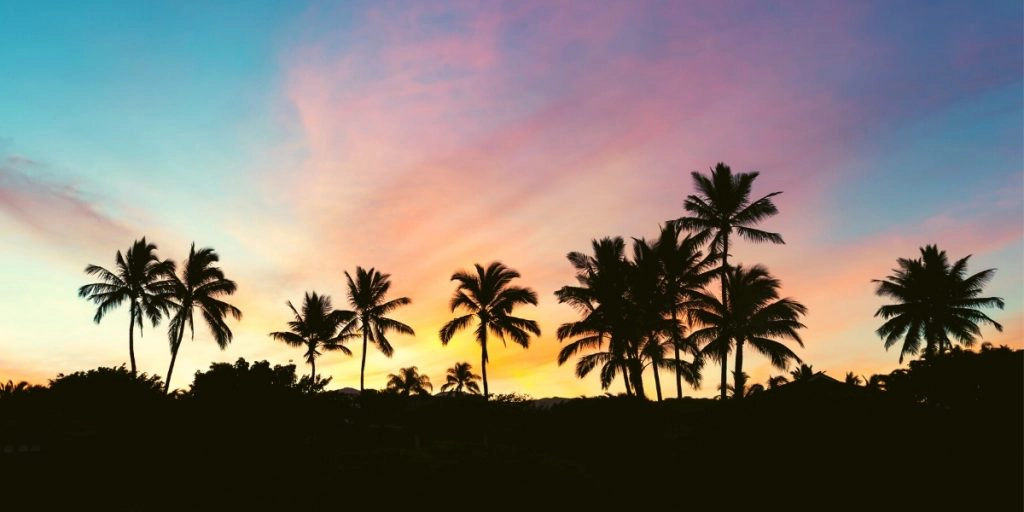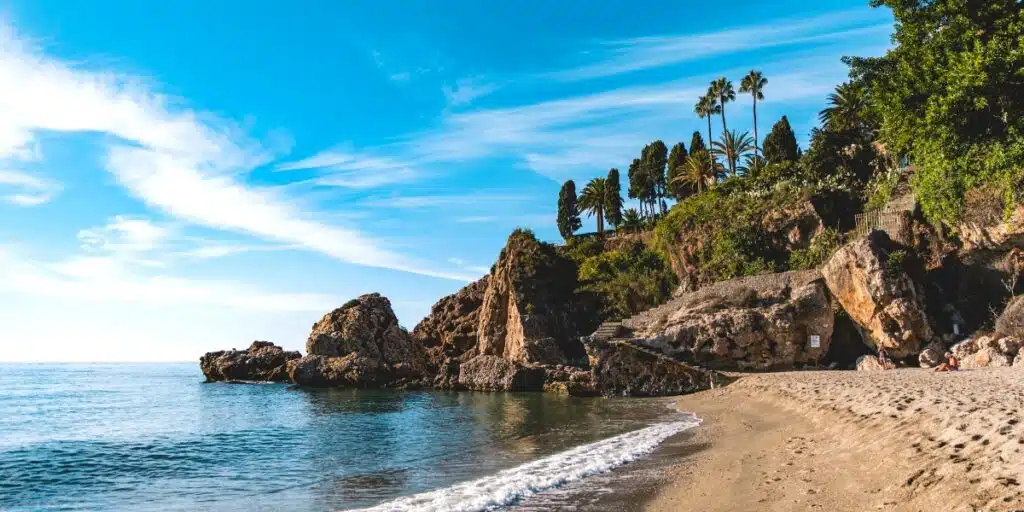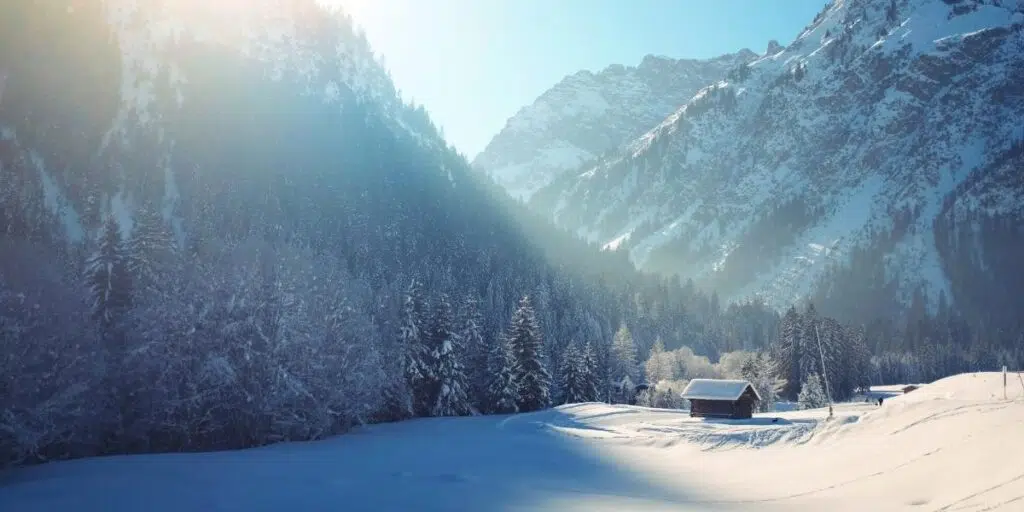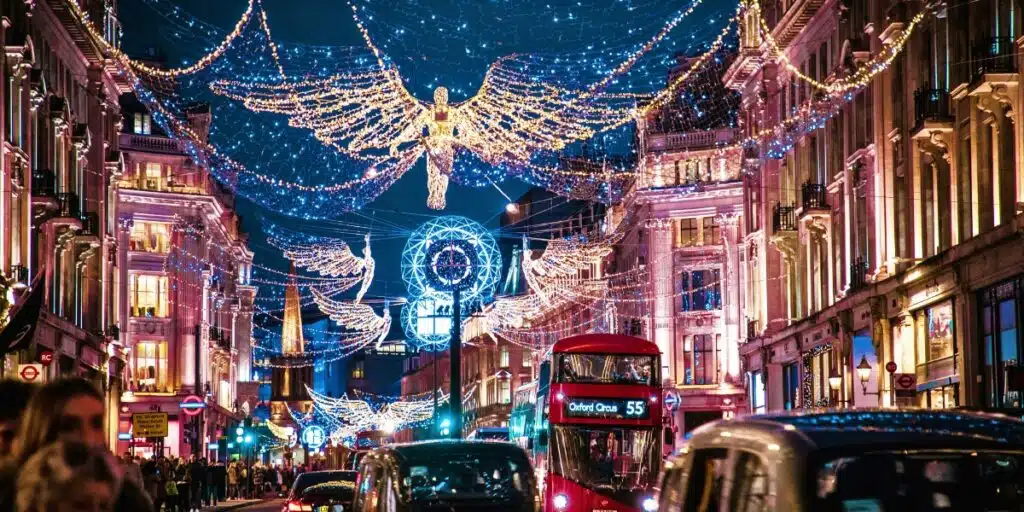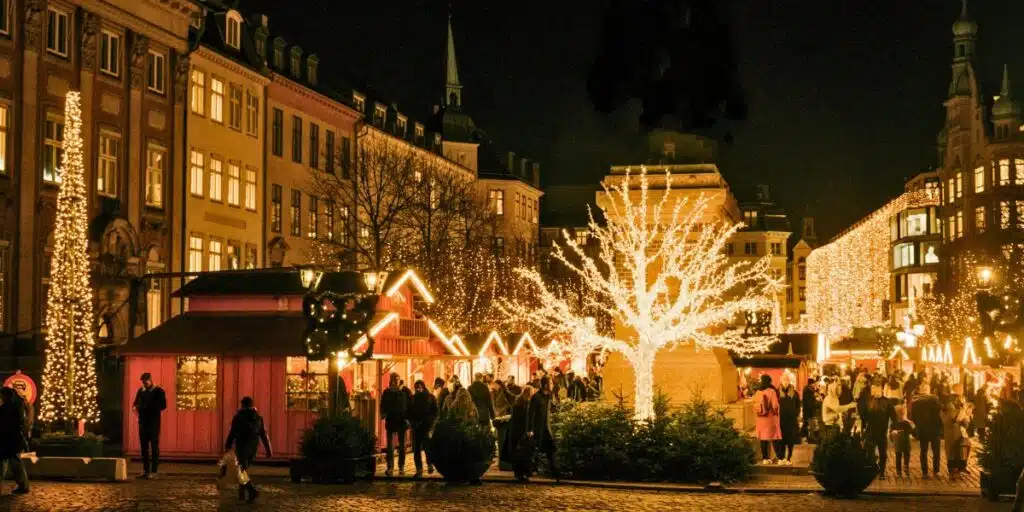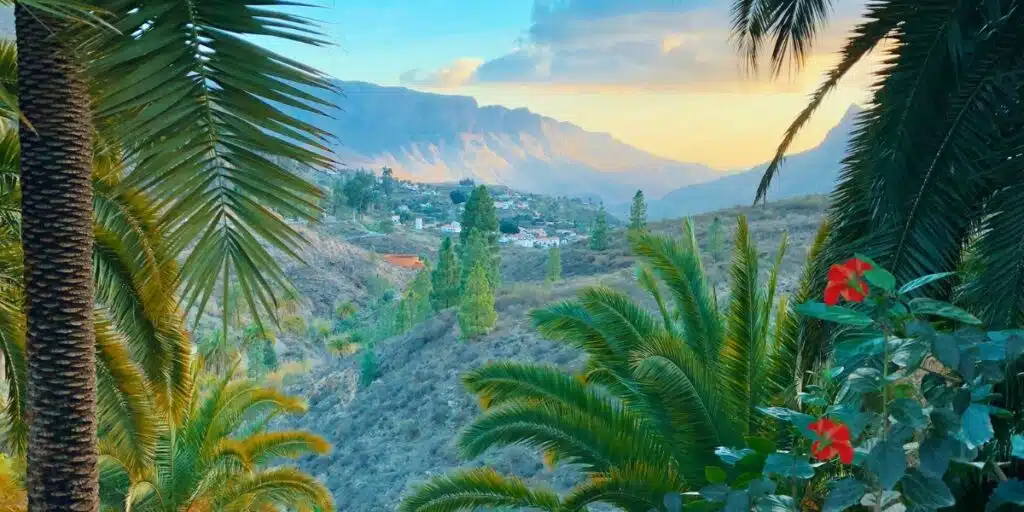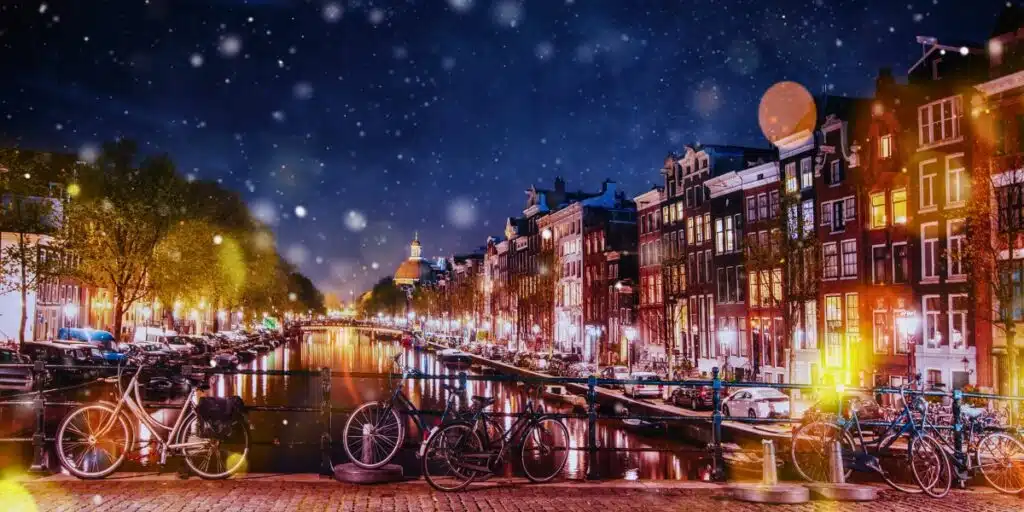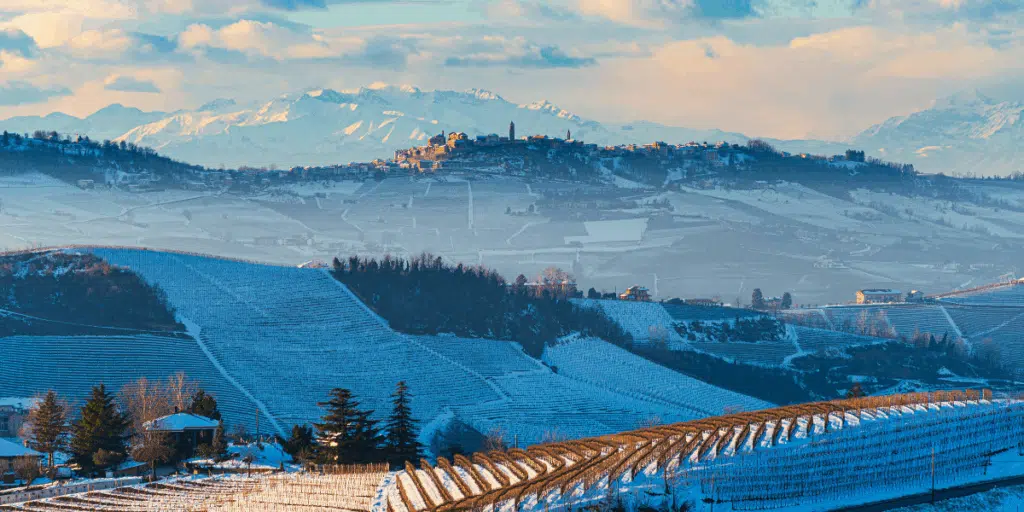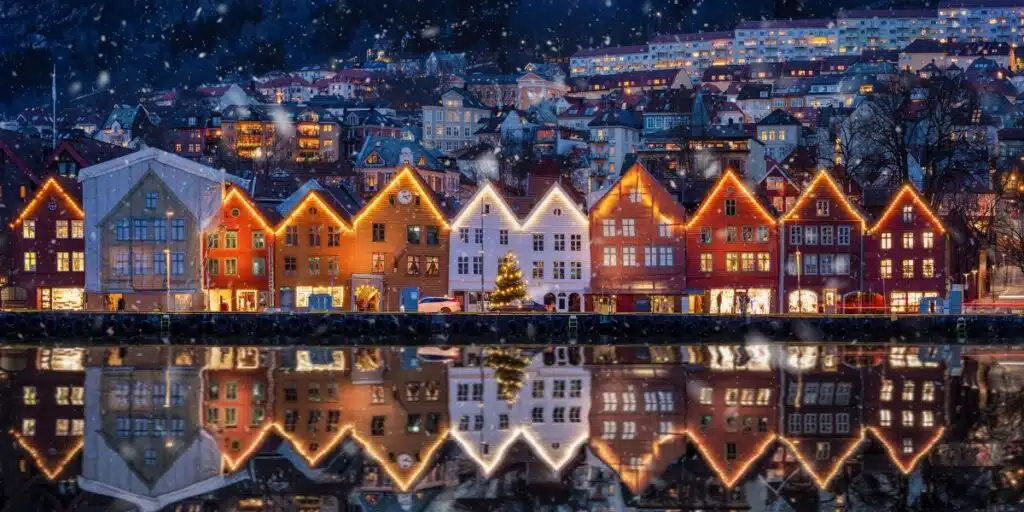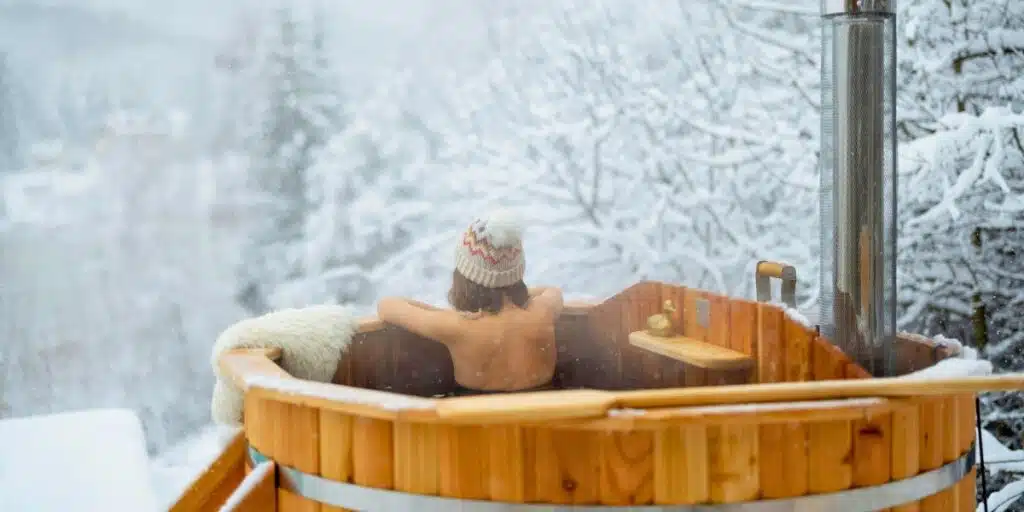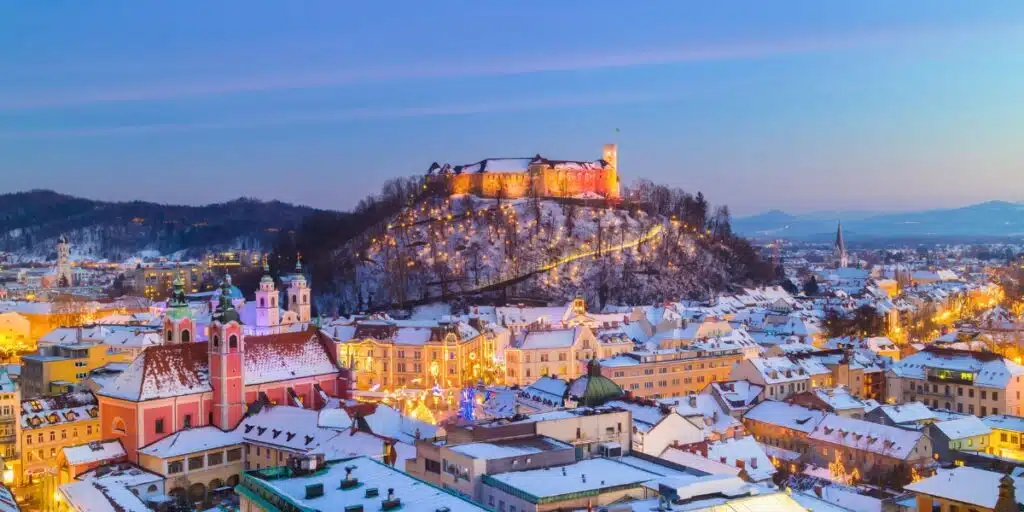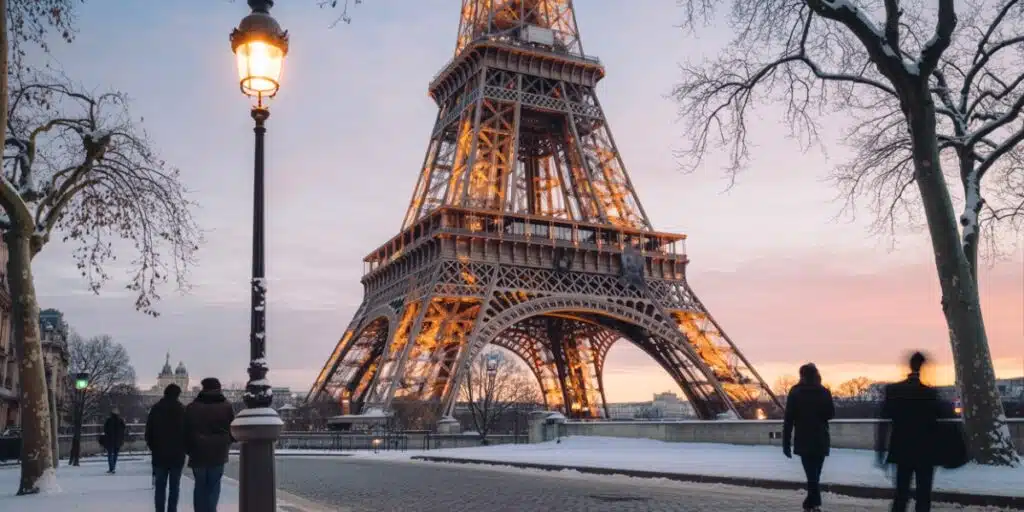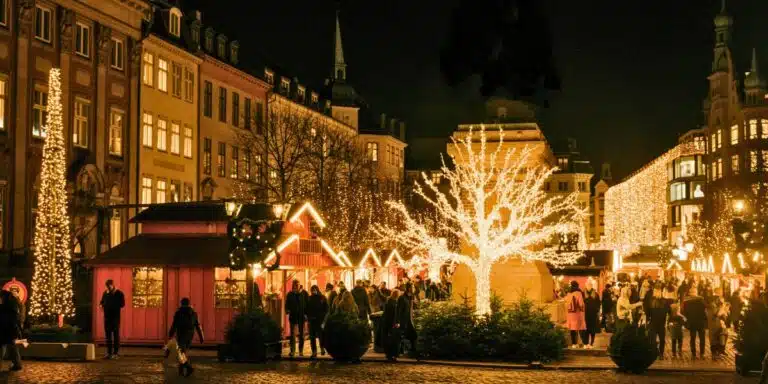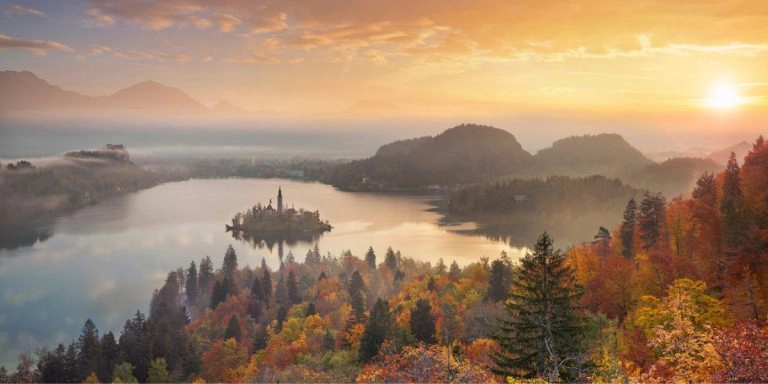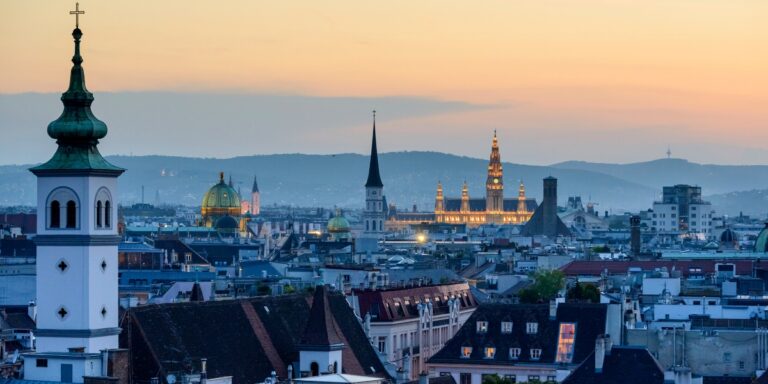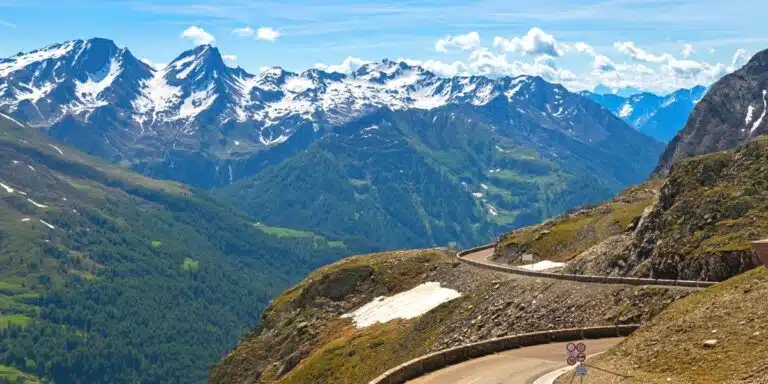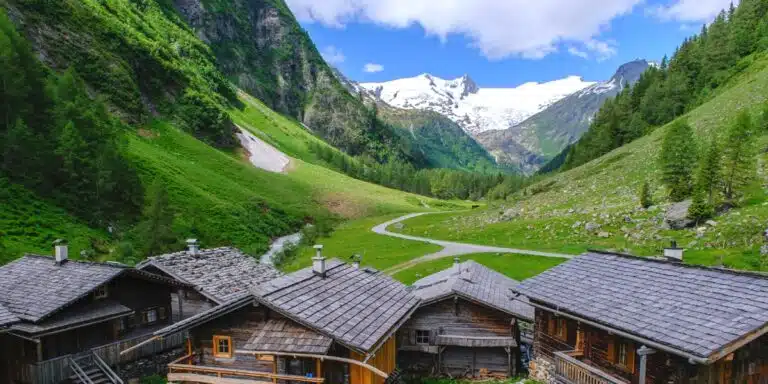This post may contain affiliate links, from which we earn an income. Click here to read our affiliate policy.
Vienna in winter is the kind of trip that stays with you long after the snow has melted. The city takes on a cinematic quality, with steaming mugs of mulled wine, ornate palaces glowing under fairy lights, and streets that seem made for long winter walks. If you’re planning a Vienna holiday in winter, you’ll find the Austrian capital at its most atmospheric.
Vienna at Christmas is famous across Europe, but there’s more to a Vienna winter than festive markets. From grand coffee houses to ice rinks in the city center, this is a place that knows how to make the cold season enjoyable. Whether you’re visiting for a Vienna New Year’s Eve celebration or simply chasing that Austria Christmas aesthetic, this guide covers everything you need to know for an amazing trip.
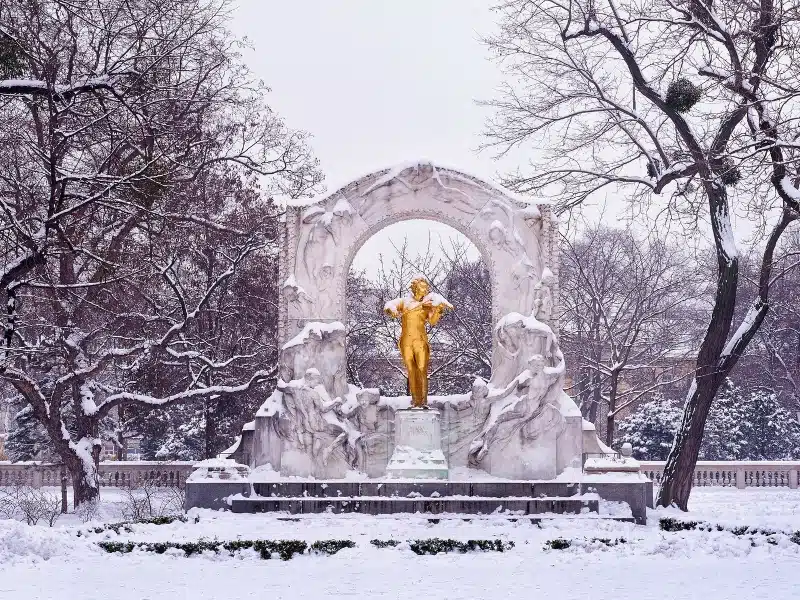
When is Winter in Vienna?
Winter in Vienna stretches from late November through early March, though December to February is when you’ll feel the season most keenly.
Vienna in December brings Christmas Markets and the sparkle of Wien Christmas festivities. January tends to be the coldest month, with snow a real possibility. February slowly tips towards longer days with a slightly softer chill.
By March, the city begins to thaw, but the winter city aesthetic lingers in the crisp mornings and lingering frost.
Is this your first time visiting Vienna? Get all the information you need in our Austria Travel Guide, including what things to pack, the best time of year to go, getting there and practical tips to help you have the best trip!
Weather in Vienna by Month
December
Vienna in December feels like walking through a Christmas card. Daytime temperatures average 0–4°C (32–39°F), though mornings can dip below freezing, so a frosty start isn’t unusual. Rainfall sits at around 40mm across the month, but that often comes as light showers or flurries of snow. You’ll get about 2–3 hours of sunlight per day, though the glow of Christmas markets and the twinkle of street lights make up for the short days.
This is the busiest winter month in Vienna, Austria, as people come for the Christmas Markets, festive concerts, and the Vienna holiday aesthetic. The air smells of mulled wine and roasted chestnuts, and the city embraces the cold with outdoor skating rinks and seasonal events. Even if the weather turns grey, Vienna at Christmas feels alive and vibrant, which is why it’s one of the most popular Christmas destinations in Europe.
January
January is when winter in Vienna is at its most intense. Average highs stay close to 2–3°C (35–37°F), but mornings and evenings often fall well below freezing, sometimes to -4°C (25°F). This is the snowiest month, so you have a decent chance of waking up to a fresh dusting over Schönbrunn Palace or the city center. Rainfall is relatively low at 30–35mm, but icy pavements can make walking tricky, so footwear with grip is essential. Daylight stretches to around 3 hours, giving you just enough time for sightseeing before dusk.
While it’s colder, January has its rewards: smaller crowds at major attractions, cheaper hotel rates compared to Vienna in December, and a more local feel to the city. Coffee houses become daily refuges, and concerts or museums are a comfortable escape from the freezing streets. If you like a quieter winter city aesthetic, January might be the most authentic time to experience Vienna in winter.
February
February in Vienna marks the gradual easing of winter, though it’s still firmly cold. Temperatures range from -1–5°C (30–41°F), with slightly longer days offering around 4 hours of sunlight. Rainfall hovers near 35mm, and while snow is less common than in January, it’s still possible, especially early in the month. The air feels a little less sharp, and you’ll start noticing brighter afternoons, even if the evenings remain chilly.
February is a great compromise for visitors: it still looks and feels like winter, but without the peak crowds of Christmas. Vienna’s New Year celebrations are past, so prices drop, yet the city continues to host concerts, exhibitions, and carnival events. If you enjoy photography, this is an underrated time for Vienna winter photos, as the softer light gives the city center and palaces a subtle beauty.
March
March in Vienna is technically spring, but the first half of the month still feels like winter. Average temperatures creep up to 2–10°C (36–50°F), and while snow is less frequent, frosty mornings are common. Rainfall increases slightly to around 40mm, and daylight jumps to 5–6 hours, which makes sightseeing easier and more pleasant.
For travelers, March is a shoulder season sweet spot. Winter in Vienna lingers in the crisp mornings, but you’ll also get a taste of warmer afternoons where a lighter jacket suffices. The city is quieter than in December, yet still alive with concerts and museum exhibitions. If you want the Austrian winter aesthetic without the harsh cold, March can be a rewarding time to visit Vienna.
Make sure you have travel insurance you can trust for your trip to Vienna. We recommend True Traveller for their 5-star TrustPilot reviews, variety of cover options, best activities cover as standard, great prices, and excellent service.
Where to Stay in Vienna in Winter
Upmarket: For a luxurious Vienna holiday, stay at Hotel Sacher Wien, a Viennese icon with old-world charm, opulent interiors, and its famous torte in the café downstairs.
Mid-range: Travelers love Hotel Das Triest, a design-focused property with comfortable rooms and easy access to the city center, balancing modern touches with a classic feel.
Budget: Urban Rooms Rathaus is a self-check-in hotel tucked inside Vienna’s Innere Stadt district. It’s not only budget-friendly but also incredibly convenient. The setup makes arrivals smooth, freeing you to settle in quickly and start exploring the city center immediately.
Hostel: For a hostel experience, Wombat’s City Hostel Vienna Naschmarkt is a great choice, with a friendly social atmosphere and excellent transport links for first-time visitors to the city.
What to Pack for Vienna in Winter
December Packing
Vienna in December is all about festive cheer mixed with bracing cold. You’ll be spending plenty of time outdoors at Christmas Markets or wandering the city center, so layering is key. Evenings often mean concerts or dinners, so something a little smarter can come in handy, too.
January Packing
January is the coldest month of Vienna’s winter, and the icy streets mean preparation matters. Locals bundle up properly, and you should too if you want to enjoy the city without constantly dashing indoors. Comfort beats style here, though you’ll still want something smart-casual for Vienna’s coffee houses or classical concerts.
February Packing
February softens the winter a little, but you’ll still need proper layers. The days are slightly brighter, so sunglasses can be surprisingly useful, especially if snow is still around. This is a month for flexibility: warm for the mornings, with the option to shed layers when you step indoors.
March Packing
March in Vienna can be confusing: some mornings still feel like winter, while afternoons hint at spring. This means a flexible wardrobe is your best friend. You’ll likely want lighter outerwear during the day, but a heavier coat at night, especially early in the month.
Other Winter Vacation Ideas
Things to Do in Vienna in Winter
Visit the Vienna Christmas Markets
The Vienna Christmas Markets are the city’s big draw, and for good reason. The main one at Rathausplatz looks like a fairytale when lit up at night, with stalls selling everything from mulled wine to hand-carved ornaments. Smaller markets like Spittelberg or Karlsplatz feel more intimate, with craft stalls tucked into narrow streets and a more local atmosphere. Each has its own personality, and part of the fun is hopping between them, comparing mugs of mulled wine and sampling roasted chestnuts along the way.
Winter in Vienna really comes alive here, with choirs singing carols and the scent of cinnamon drifting through the air. If you want to take Vienna winter photos, the glow of lights against the early dusk is perfect. Be sure to bring cash for the stalls and give yourself time to linger; it’s not just about shopping, but about soaking up the Austrian Christmas aesthetic that makes the city so special at this time of year.
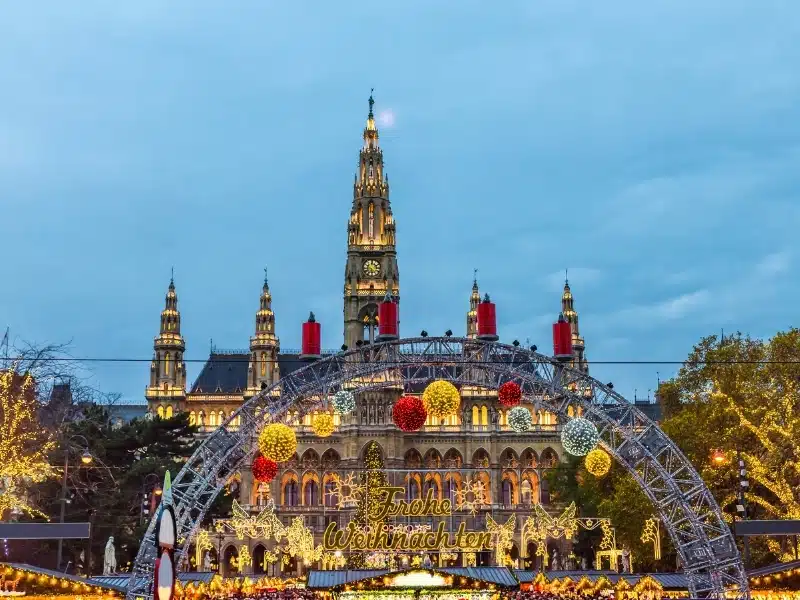
Tour Schönbrunn Palace
Schönbrunn Palace is one of Vienna’s most famous landmarks, and winter gives it a unique atmosphere. The gardens are stripped back and dramatic, the fountains frozen, and the yellow façade stands out against the muted winter skies. Inside, the palace offers a warm refuge, with guided tours that lead you through imperial apartments once used by the Habsburgs. The sheer opulence of the décor contrasts beautifully with the stark season outside, making the experience even more memorable.
In December, a Christmas market fills the courtyard, so you can follow up your tour with mulled wine or traditional Austrian pastries. Even without the market, the palace feels like a winter city highlight. Visiting during colder months means fewer crowds, giving you more space to enjoy the grandeur. Whether it’s your first time in Vienna or a return trip, Schönbrunn has a different kind of magic in winter.
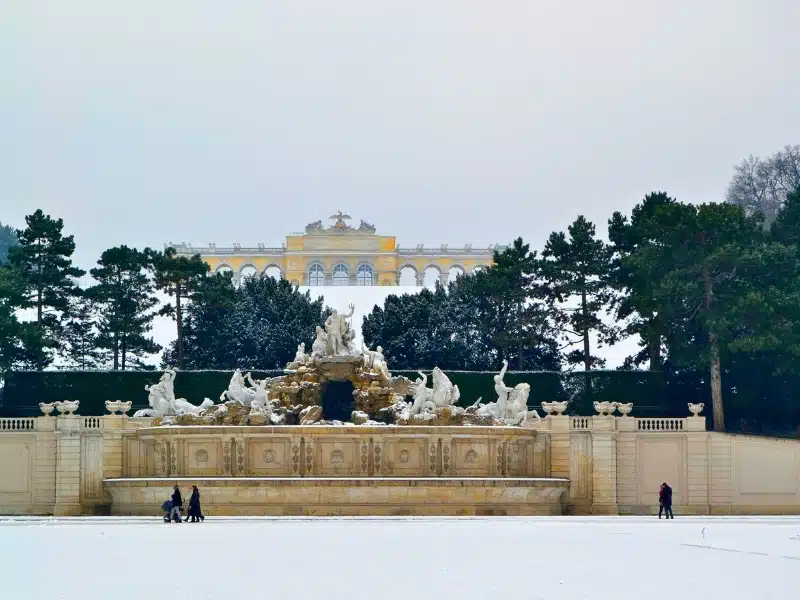
Warm Up in Coffee Houses
Coffee houses in Vienna aren’t just places to grab a drink; they’re an institution, part of the city’s culture. In winter, when the cold bites, they feel even more essential. Sit down at Café Central under chandeliers and vaulted ceilings, or slip into Demel for coffee and a slice of sachertorte, and you’ll see why locals spend hours here. The pace is unhurried, the service polished, and there’s something soothing about being surrounded by polished wood and the quiet hum of conversation.
On a winter holiday, these cafés are perfect pit stops between sights. Order a melange or hot chocolate, warm your hands, and watch the snow drift past the windows. There’s no better way to pause and reset. The city’s coffee houses embody the winter Vienna aesthetic: elegant, timeless, and welcoming.
Ice Skating in the City Center
From late January into March, Rathausplatz transforms into one of the most beautiful ice rinks in Europe. Vienna Ice World spreads across the square, with winding paths of ice lit up under fairy lights, making skating here a wonderful festive experience. Even if you’re not confident on the ice, watching from the sidelines with a mug of mulled wine is part of the fun.
The setting is what makes it so special. The gothic architecture of the Rathaus looms above, and the rink itself feels like a winter festival, complete with food stalls and music. Families, couples, and groups of friends all share the ice, creating an atmosphere that’s lively but not rushed. It’s one of the most photogenic spots in Vienna during winter, especially at dusk when the lights glow against the darkening sky.
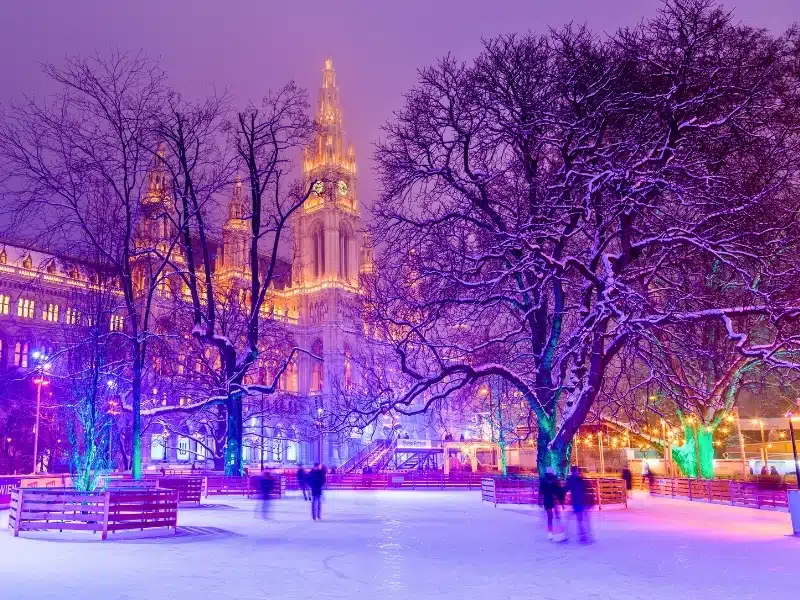
Explore the MuseumsQuartier
Vienna in winter means you’ll want some indoor days, and the MuseumsQuartier is ideal for that. This huge cultural complex brings together museums, galleries, cafés, and event spaces, all within walking distance of the city center. The Leopold Museum is a highlight, with its unrivalled collection of works by Egon Schiele, while the Kunsthalle focuses on contemporary art. Together, they make a day of culture both easy and engaging.
The courtyards of the MuseumsQuartier often host installations or seasonal events, even in the colder months. It’s a place where you can balance sightseeing with rest, ducking into cafés between exhibitions or warming up over lunch. If the weather turns especially harsh, spending a day here is one of the best ways to enjoy Vienna in the winter months without braving the cold for too long.
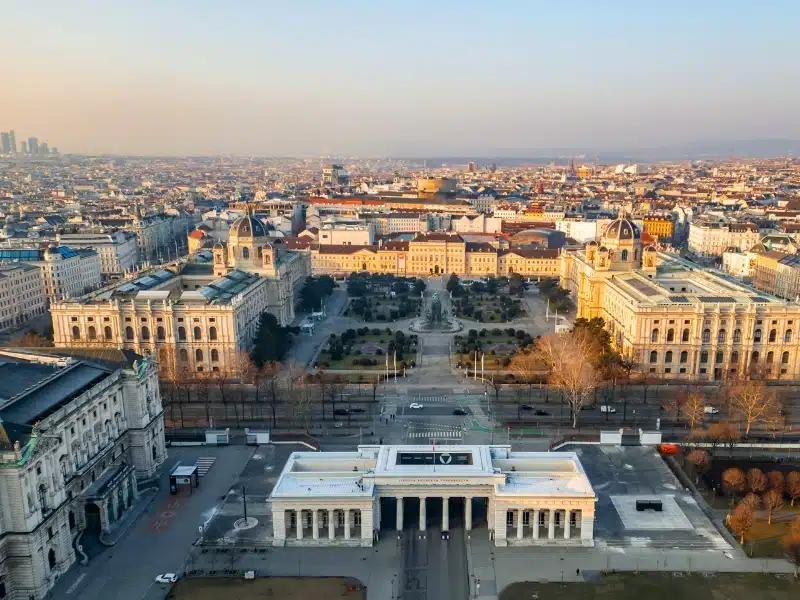
Attend a Classical Concert
Vienna is the city of music, and hearing a concert here is one of the best ways to connect with its heritage. In winter, when the evenings are dark and cold, stepping into the golden glow of the Musikverein or the grand Vienna State Opera feels especially atmospheric. The halls themselves are stunning, and the music of Mozart, Strauss, and Beethoven resonates in a way that feels deeply tied to the city’s identity.
Tickets sell out fast in December, especially around Christmas and New Year’s Eve, so it’s worth booking early. There are also smaller venues where chamber music is performed in more intimate settings, often in historic halls. Whichever you choose, it’s an experience that stays with you. For many visitors, it’s the highlight of their Vienna itinerary, and the winter season only adds to the sense of occasion.
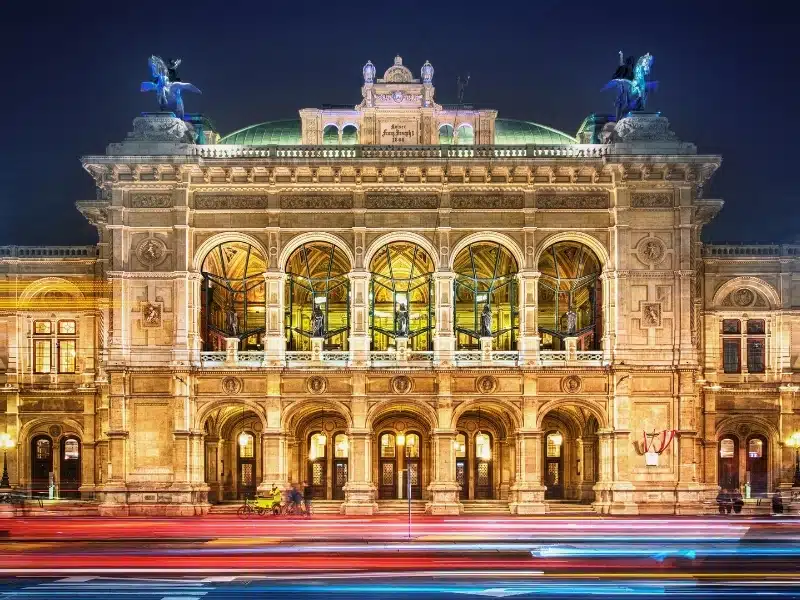
Ride the Vienna Ring Tram
The Ring Tram is a simple way to see Vienna city, but in winter it becomes even more appealing. Instead of walking the Ringstrasse in freezing temperatures, you can ride comfortably while still catching views of landmarks like the State Opera, the Parliament, and the Hofburg Palace. The tram includes audio commentary, so you learn about the architecture and history as you go.
For first-time visitors, it’s a great introduction to the city. For returning travellers, it’s a warm and efficient way to enjoy Vienna during winter without the icy winds. It doesn’t take long, about 25 minutes for a full loop, so you can easily fit it in between other activities.
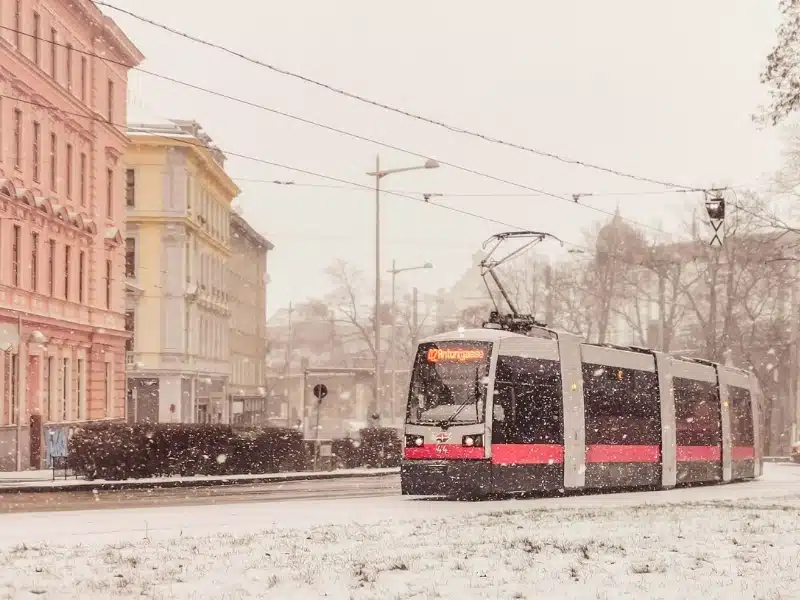
Take a Walking Tour
Even in winter, Vienna rewards walking. Guided tours take you through the city center, weaving between grand boulevards and tucked-away courtyards. The cold adds atmosphere: breath steaming in the air, footsteps echoing on frosty streets, and the occasional pause in a café for warmth. Local guides add context that you’d miss wandering alone, from stories of the Habsburgs to tales of everyday life in Vienna.
Food tours are also popular in winter, combining historic stops with tastings of local dishes and drinks. It’s a way to understand the city through its traditions, while breaking up the cold with hearty food and mulled wine. Wrapped up well, a walking tour can be one of the most rewarding experiences of your Vienna holiday.
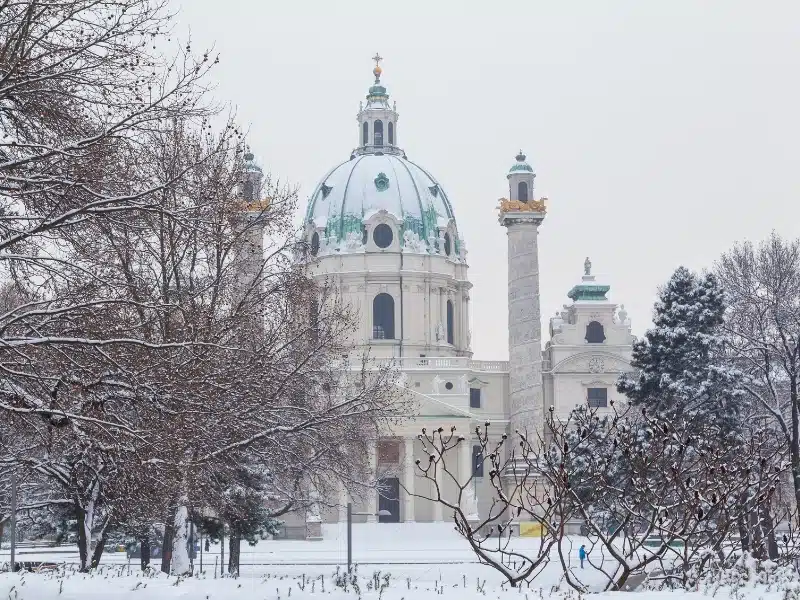
Celebrate Vienna New Year’s Eve
Vienna New Year’s Eve is a full-scale celebration. The Silvesterpfad (New Year’s Trail) runs through the city center, filling the streets with music stages, food stalls, and dancing. Crowds gather to watch fireworks burst over the city, and there’s a shared sense of excitement that feels both grand and festive. It’s busy, but in a way that feels welcoming rather than overwhelming.
If you want something more formal, Vienna’s New Year’s Eve balls are legendary. Dressed in evening gowns and tuxedos, you can waltz in ornate halls and experience a tradition that few other cities can match. Whether you spend it outside in the streets or inside at a ball, the Vienna New Year feels like the perfect finale to the winter season.
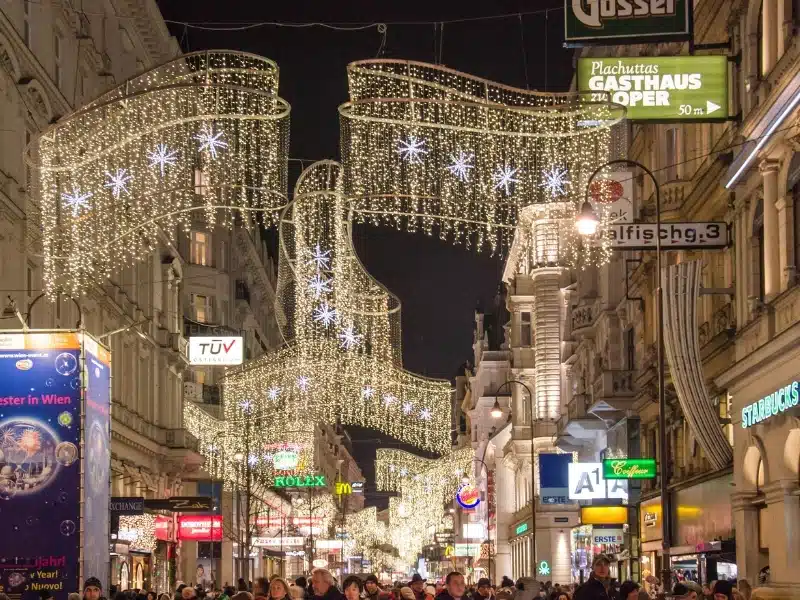
Visit the Otto Wagner Church at Steinhof
If you want something different from the usual Vienna city highlights, take the tram out to the Otto Wagner Church at Steinhof. Built in 1907, this art nouveau masterpiece sits on a hilltop in the grounds of a former hospital. In winter, when the trees are bare and the light is low, the golden dome stands out dramatically against the grey sky.
It’s not on the usual tourist trail, but it rewards anyone who makes the trip. The interior is just as striking, with stained glass, mosaics, and Wagner’s unique approach to modernist design. Because it’s quieter than Schönbrunn or the Hofburg, you’ll often have time to wander slowly and take in the details. For Vienna winter photos with a difference, this place delivers.

Try Austrian Comfort Food
Winter in Vienna is a time of hearty food. Order Wiener schnitzel, goulash, or Kaiserschmarrn in a traditional restaurant, ideally paired with Austrian wine or beer. Figlmüller Wollzeile is the most famous schnitzel spot, where the cutlets are so large they spill over the plate. Plachutta is where you go for Tafelspitz, a classic Viennese boiled beef dish served in broth with potatoes and horseradish.
For a more local feel, Gasthaus Pöschl offers excellent goulash and seasonal dishes in a cosy setting, while Zum Schwarzen Kameel is ideal for open sandwiches and snacks during the day. If you’re after dessert, head to Café Landtmann for Kaiserschmarrn – fluffy shredded pancakes that taste even better when it’s freezing outside.
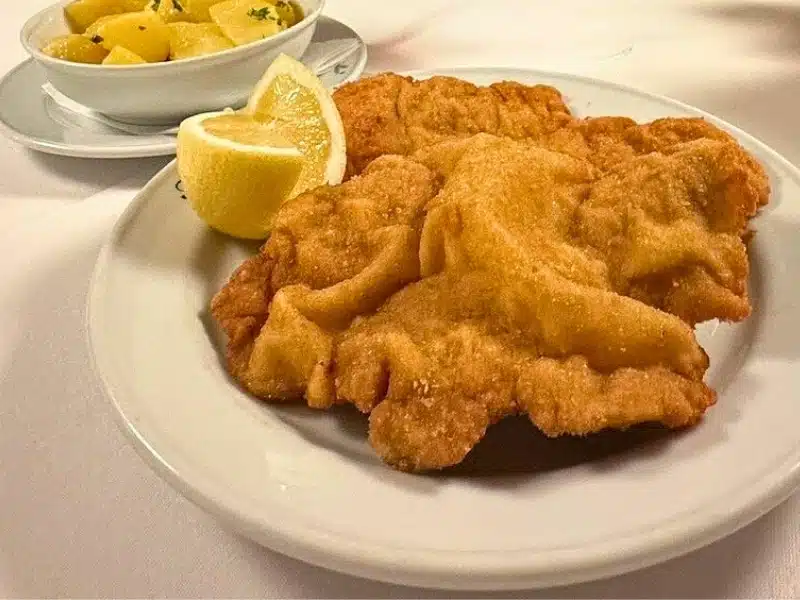
Take Vienna Winter Photos
Don’t underestimate how photogenic Vienna is during winter. From snowy Schönbrunn gardens to Rathausplatz at dusk, the city looks its best in the colder months.
Vienna at Christmas, especially, provides countless photo opportunities. Bring a camera or simply use your phone, and you’ll go home with images that define the Christmas in Europe aesthetic.
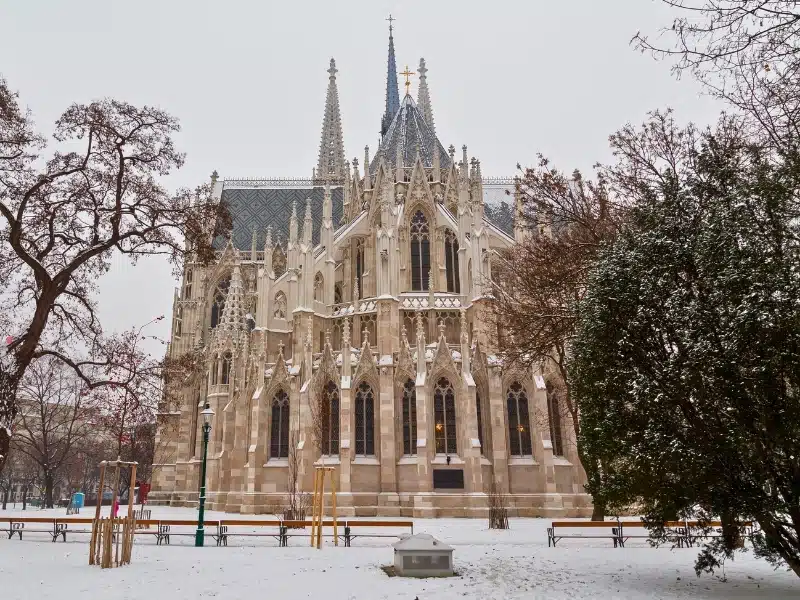
Take a Winter Day Trip from Vienna
Vienna makes a great base for exploring nearby Austria in winter, and a short journey can change the atmosphere entirely.
A Bratislava day trip is the easiest option, where you’ll find pastel-coloured streets, a hilltop castle, and enough coffee houses to warm up between walks. Melk Abbey (90 minutes by train or car) is another highlight, with its baroque architecture standing proudly above the Danube. In winter, it feels almost theatrical against the grey skies.
For something more scenic, the Wachau Valley (90 minutes by car or this excellent small group guided tour) offers vineyards, castles, and riverside villages. Even in the cold, the landscapes have a quiet beauty, and tasting Austrian wine is never a bad idea.
If you don’t mind a longer trip, a group tour to Salzburg is worth it. The birthplace of Mozart and backdrop for The Sound of Music looks especially charming, dusted with snow, and its old town feels like stepping into a Christmas in Europe aesthetic.
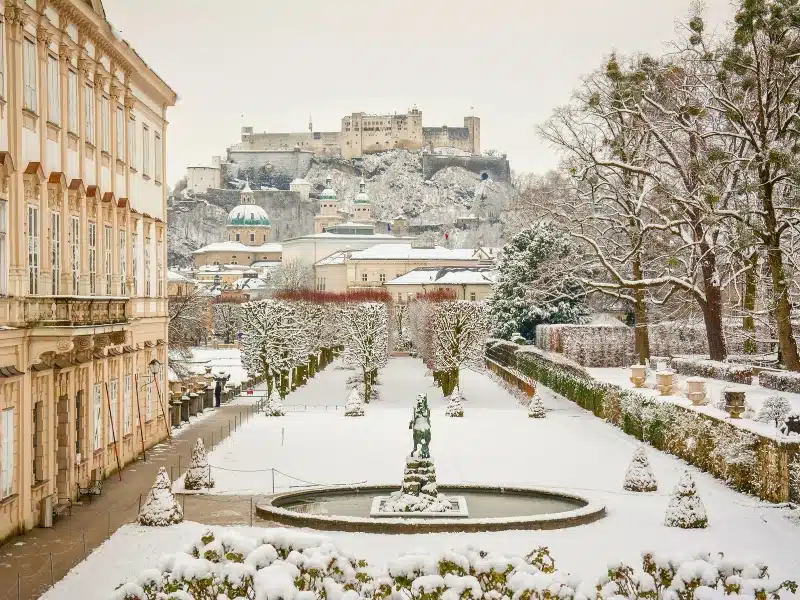
Vienna Travel Tips
Booking accommodation early is essential if you’re planning to visit Vienna in December. Hotels fill up quickly for the Christmas market season, and prices rise sharply the closer you get to arrival, especially around Vienna’s New Year’s Eve.
A Vienna City Card is worth considering, especially in winter when you’ll rely more on public transport. It covers unlimited travel on trams, buses, and the metro, plus discounts at attractions and museums, which adds up quickly. Get your Vienna City Card here.
Vienna’s tram network is your friend during the cold months. Hopping between stops lets you explore neighbourhoods without long walks in icy conditions. The Ring Tram, in particular, is a comfortable way to see major landmarks in winter Vienna.
Each Christmas market serves mulled wine in its own souvenir mug, and the flavour varies too. Try more than one, from the big city center markets to smaller neighbourhood ones, to get a true taste of Vienna at Christmas.
Give yourself at least half a day for Schönbrunn Palace. Between the guided tour, the gardens, and possibly a winter market, it’s not a quick stop. You’ll appreciate it more if you’re not rushing.
Coffee houses can get crowded in the afternoons, especially during winter. If you want to linger with a melange and slice of cake, try going mid-morning or early evening for a quieter experience.
Footwear matters more than you think. Vienna pavements can be icy in January, so bring boots with grip. A pair that balances practicality with comfort means you can sightsee without worrying about slipping.
A guided tour can transform how you experience Vienna. Stories about the Habsburgs, the architecture, and even small everyday details help the city come alive in a way guidebooks can’t.
Market stalls and smaller cafés often prefer cash, so don’t rely entirely on cards. ATMs are easy to find, but carrying some euros makes things smoother, especially for food and drinks at Christmas markets.
Finally, give yourself enough time in the city. A weekend scratches the surface, but Vienna during winter deserves at least four or five days if you can manage it. You’ll see more than just the main sights and start to feel the rhythm of the city.
Looking for more Austrian travel inspiration? Check out these top posts…
22 Best Christmas Cities in Europe for a Festive Experience
Autumn in Europe: 28 Stunning Destinations for Fall
Best Cities in Austria for an Amazing Visit!
Driving in the Alps: Top Tips & Best Routes
Austria Road Trip: The Best Itinerary, Map & Tips
Innsbruck In Summer: Everything You Need To Know!
Love it? Pin it!
